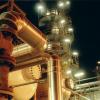I think there are two or (maybe three) main questions that i think should be treated separately.
End of Curve operation,
pumps operating right down their curve will generate high power, maybe more than motor is designed for.
The motor might have some protections in place to trip the pump to prevent motor damage.
For me, End of Curve operation doesn't stop at the flowrate where the pump curve is drawn, it continues down following a similar path.
The vendor just hasn't plotted it.
The flow will be what ever the system resistance requires on the pump curve.
Cascade trip
These are trips that occur due to knock on effects from other trips.
An example could be a closure of an actuated valve due to a trip will result in low flow to a pump and a flow transmitter with a low low setting will trip the pump.
In these instances, we know that the valve closure will result in low flow, so we trip the pump automatically.
Instead of waiting for the cascade trip and potentially pump damage if it doesn't occur.
In your scenario, the trip of one pump will result in the other pumps operating down their curves to maintain the system flow rate as a downstream control valve opens up to maintain level or flow.
As per above, this could result in high power demand required of the motor, resulting in a trip.
But you wouldn't want to trip all the pumps in this scenario, as you have a spare that should come online and return the system to stable operation.
Pump Trip System Response
Following the pump trip, the remaining two pumps will continue to run, but the reduced flow (or build up of level) will result in the control system opening up the flow / level control valve. This reduces the system resistance and the pumps can operate at a higher flow due to the lower resistance in the discharge, moving down their curve.
Depending on the flow demands, the control valve could open up fully, allowing the pumps to move further down their curves, potentially beyond EOC.
PSV Relief Case.
What is the overpressure scenario that you are protecting.
The scenario described seems odd, relief flow of two pumps (3000 m3/h) operating at low discharge pressure (end of curve) which is less than the normal operating flow of 3500 m3/h.
I'm guessing there is a HP/LP interface downstream of the pumps?
But then why isn't it a concern when all three pumps are online and operational?
Without a sketch its hard to confirm.
Is the tripping of one of the pumps due to a power failure critical to the overpressure scenario ? (this doesn't sound relevant, but you know the system).
I would recommend ignoring the old calculation scenario in the first instance, and evaluating it from first principles.
The old calculation scenario might be correct, but its good to explore the basis.
My guess on the overpressure scenario based on what you have shared is downstream, due to a control valve failure.
Then i would look at generating the system curve for your downstream piping based on the CV being fully open and accounting for the PSV set pressure.
Produce your combined pump curve for 2 and 3 pumps in operation based on the pumps operating in parallel (even extrapolate them beyond the plotted EOC).
You should be able to overlay them and where the pump curve intercepts with the system curve, this would be your required relief rate.
Best of luck.

 FB
FB










